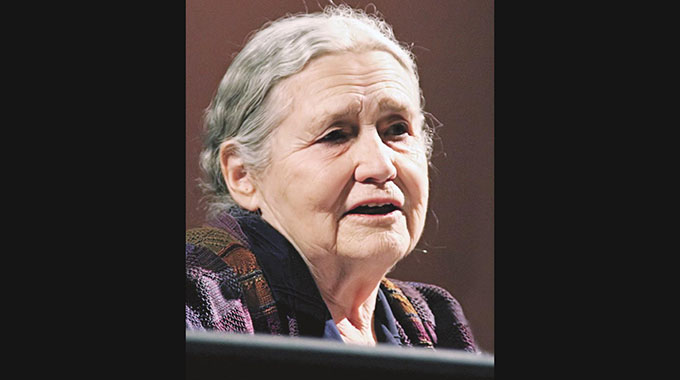Revisiting Lessing’s ‘The Story of the Non-Marrying Man’

Gracious Madondo Literature Today
African literature is like a kaleidoscope. It’s comprises writers from different races, cultural, social and political backgrounds.
Rising from the two major periods in African history – the pre- and post-colonial, writers have all been products of the prevailing social, cultural and political milieu.
One such writer who is a product of her own cultural and political milieu is Doris Lessing.
Born to white immigrants parents who were some of the pioneer farmers in the then Southern Rhodesia, Lessing was a liberal writer whose writing reflects the “behind the scenes” happenings within the white community of the time.
A Nobel laureate, Lessing’s most popular book is “The Grass is Singing” (1950) which depicts life on white farms in colonial Rhodesia.
Upon publication, “The Grass is Singing” caused such an uproar among whites who viewed the book as an affront to white sensibilities and the maintenance of a sense of superiority towards the indigenes blacks.
What irked the white establishment at the time was that the book’s main narrative was centred on a failed white farmer (Dick) whose wife was suspected of having a relationship with her black domestic servant (Moses).
Lessing was forced to leave Rhodesia for England after the white colonial regime declared her a persona non grata. But the young Lessing was never deterred in her quest of exposing the excesses of white Rhodesians during colonialism.
Following on the success of the “The Grass is Singing” Lessing was to publish a short story anthology titled “The Story of the Non-Marrying Man and Other Stories” (1972), which adopts a voyeuristic style in narrating the various accounts of life in colonial Southern Africa.
The anthology contains 13 short stories whose themes range from racial discrimination, love, betrayal, adultery, and self-doubt. These are nuanced stories whose main protagonists are whites with the indigenous blacks always a permanent backroom feature.
The title story “The Story of a Non-Marrying Man” is a story about a British prospector, scouting the landscape of Rhodesia in search of gold. The man is aptly called Johnny Blackworthy, who goes on long forays on the African landscape.
He is a polite and very gentle bigamist, a vagrant whose end of every marriage was accompanied by a thank-you letter and ended his life known to the African villagers among whom he lived with as “The Man Who Has No Woman”.
He is a philanderer and a loner who leaves a trail of broken hearts and yet the women left always have fond memories of him.
As symbolised by his adventures in search of gold, the un-marrying man goes against his tradition and social expectations of settling down with a woman and having a family and goes around meeting different women wherever his gold prospects take him.
Like many other white writers writing stories set in Africa, Lessing tells the usual racially stereotyped story of a white man who has no money or bright future prospects. The man is depicted as one who has gone native and he associates himself with the indigenes of Africa.
David Conrad in “The Heart of Darkness”, is famous for creating such racial stereotypes of a white man going native and his association with black people is given as a reason for his impoverishment.
Kirk, a white man who has lived for a very long time in Africa without contact or communication with the Empire turns savage and cannibalistic like the Africans in the Congo whom he had made a part of his life to the extent of marrying a black woman.
The description of each of the single items found in Johnny’s backpack seems innocent until the discovery of a sack full of maize in the bag.
In describing the contents of the sack, the narrator writes: “The presence of the maize flour was a statement, and probably unambiguous, for the Africans ate the maize-meal porridge as a staple food. It was cheap, easily obtainable, quickly cooked, nourishing but the white men did not eat it, at least not as the basis of their diet because they did not wish to be put the same level as Africans. The fact that this man carried it . . . he’s probably gone native”.
In short, Blackworthy is a non-conformist who repudiates the rigid and puritanical ways of living expected of him as a white man.
The theme of race discrimination is one of the most dominant themes in the anthology. The story is divided into the white people who have more rights and the exploited blacks.
The path to success for the black man is very limited and only the white man makes it in the business of mining, farming or any other trade because they only are given the room to grow as can be denoted from Lessing’s statement in the story “The Story of the Non-Marrying Man”, when she says “it was mostly a white man’s road, for the Africans moving on foot used their quicker, short-cutting paths”.
At this point in narration, Lessing seems to lose her liberalistic touch as her racial prejudices become apparent in her narration showing how difficult it is for one to commit racial or class suicide especially if one is a beneficiary of such a skewed oppressive system.
Lessing’s writing is compelling when it comes to describing the African landscape. Her description is an emotional one as evidenced in “A Year In Regent’s Park”.
In the story Lessing describes in much details the passing seasons of the year and the beauty that comes with it. She also draw parallels between the bright, beautiful and warm African weather to the cold and ice of European countries such as Sweden and Russia which she describes as “like being shut inside a caul of ice, when the winter lengthens itself so”.
Her love for Africa is unbound. She is much intrigued by the weather, the landscape, the minerals but she depicts the African people as second class citizen associating them with primitive behaviours and poverty. She does not liberate the African soul but instead leaves them with the feeling of being the inferior race.
“The Story of a Non-Marrying Man And Other Stories” is a fascinating story, more-so to those with the curious enough to want to know what went on behind the scenes, behind the public glare in most white families.
Lessing, who died five years ago, was an award-winning, short story writer, poet, playwright and novelist.
Her novels include “The Grass is Singing” (1950), the sequence of five novels collectively called “ Children of Violence” (1952-69), “The Golden Notebook’’(1962), “The Good Terrorist” (1986) and five novels known as “Canopus in Agros: Achieves” (1979-1983).
Lessing received the 2007 Nobel Prize in Literature and was the 11th woman to get such recognition.









Comments